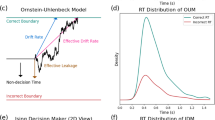Abstract
In order to accommodate empirically observed violations of the independence axiom of expected utility theory Becker and Sarin (1987) proposed their model of lottery dependent utility in which the utility of an outcome may depend on the lottery being evaluated. Although this dependence is intuitively very appealing and provides a simple functional form of the resulting decision criterion, lottery dependent utility has been nearly completely neglected in the recent literature on decision making under risk. The goal of this paper is to revive the lottery dependent utility model. Therefore, we derive first a sound axiomatic foundation of lottery dependent utility. Secondly, we develop a discontinuous variant of the model which can accommodate boundary effects and may lead to a lexicographic non-expected utility model. Both analyses are accompanied by considering some functional specifications which are in accordance with recent experimental results and may have significant applications in business and management science.
Similar content being viewed by others
REFERENCES
Battalio, R.C., Kagel, J.H. and Jiranyakul, K. (1990), Testing between alternative models of choice under risk: Some initial results, Journal of Risk and Uncertainty 3: 25-50.
Becker, J.L. and Sarin, R.K. (1987), Lottery dependent utility, Management Science 33: 1367-1382.
Camerer, C.F. (1992), Recent tests of generalized utility theories, in W. Edwards (ed.), Utility: Measurement, Theories, and Applications, pp. 207-251. Dordrecht.
Camerer, C.F. and Ho, H.T. (1994), Violations of the betweenness axiom and nonlinearity in probability, Journal of Risk and Uncertainty 8: 167-196.
Chew, S.H. (1989), Axiomatic utility theories with the betweenness property, Annals of Operations Research 19: 273-298.
Chew, S.H. and Epstein, L.G. (1989), A unifying approach to axiomatic nonexpected utility theories, Journal of Economic Theory 49: 207-240.
Chew, S.H., Epstein, L.G. and Segal, U. (1991), Mixture symmetry and quadratic utility, Econometrica 59: 139-163.
Chipman, J.S. (1971), Non-Archimedean behavior under risk: An elementary analysis with application to the theory of assets, in J.S. Chipman, L. Hurwicz, M.K. Richter and H.F. Sonnenschein (eds.), Preferences, Utility, and Demand: A Minnesota Symposium, pp. 289-318. New York.
Cohen, M. (1992), Security level, potential level, expected utility: A three-criteria decision model under risk, Theory and Decision 33: 101-134.
Cohen, M. and Jaffray, J.Y. (1988), Preponderence of the certainty effect over probabillity distortion in decision making under risk, in B.R. Munier (ed.), Risk, Decision, and Rationality, pp. 173-187. Dordrecht.
Conlisk, J. (1989), Three variants on the Allais Example, American Economic Review 79: 392-407.
Debreu, G. (1964), Continuity properties of Paretian Utility, International Economic Review 5: 285-293.
Dekel, E. (1986), An axiomatic characterization of preferences under uncertainty: Weakening the independence axiom, Journal of Economic Theory 40: 304-318.
Diecidue, E., Schmidt, U. and Wakker, P.P. (1999), A theory of the gambling effect. Unpublished manuscript, Tilburg University.
Encarnación, J. (1964), Constraints and the firmt's utility function, Review of Economic Studies 31: 113-120.
Essid, S. (1997), Choice under risk with certainty and potential effects: A general axiomatic model, Mathematical Social Sciences 34: 223-247.
Ferguson, C. (1965), The theory of multidimensional utility analysis in relation to multiple-goal business behavior: A synthesis, Southern Economic Journal 32: 169-175.
Fishburn, P.C. (1971), A study of lexicographic expected utility, Management Science 17: 672-678.
Gigliotti, G. and Sopher, B. (1993), A test of generalized expected utility theory, Theory and Decision 35: 75-106.
Gilboa, I. (1988), A combination of expected utility and maxmin decision criteria, Journal of Mathematical Psychology 32: 405-420.
Grandmont, J.M. (1972), Continuity properties of von Neumann-Morgenstern utility, Journal of Economic Theory 4: 45-57.
Green, J.R. and Jullien, B. (1988), Ordinal independence in nonlinear utility theory, Journal of Risk and Uncertainty 1: 355-387.
Gul, F. (1991), A theory of disappointment aversion, Econometrica 59: 667-686.
Hadar, J. and Russell, W.R. (1969), Rules for ordering uncertain prospects, American Economic Review 59: 25-34.
Harless, D.W. (1992), Predictions about indifference curves inside the unit triangle: A test of variants of expected utility theory, Journal of Economic Behavior and Organization 18: 391-414.
Harless, D.W. and Camerer, C.F. (1994), The predictive utility of generalized expected utility theories, Econometrica 62: 1251-1289.
Hey, J.D. and Orme, C. (1994), Investigating generalizations of expected utility theory using experimental data, Econometrica 62: 1291-1326.
Jaffray, J.Y. (1988), Choice under risk and the security factor: An axiomatic model, Theory and Decision 24: 169-200.
Kahneman, D. and Tversky, A. (1979), Prospect theory: An analysis of decision under risk, Econometrica 47: 263-291.
Karni, E. and Schmeidler, D. (1991), Utility theory with uncertainty in: W. Hildenbrand and H. Sonnenschein (eds.), Handbook of Mathematical Economics, Vol. IV, pp. 1763-1831. Amsterdam.
Machina, J.M. (1982), Expected utility analysis without the independence axiom, Econometrica 50: 277-323.
Neilson, W.S. (1992a), Some mixed results on boundary effects, Economics Letters 39: 275-278.
Neilson, W.S. (1992b), A mixed fan hypothesis and its implications for behavior toward risk, Journal of Economic Behavior nd Organization 19: 197-211.
Newman, P. and Read, R. (1961), representation problems for preference orderings, Journal of Economic Behavior 1: 149-169.
Quiggin, J.P. and Wakker, P. (1994), The axiomatic basis of anticipated utility: A clarification, Journal of Economic Theory 64: 486-499.
Puppe, C. (1991), Distorted Probabilities and Choice under Risk. Berlin.
Schmidt, U. (1998), A measurement of the certainty effect, Journal of Mathematical Psychology 42: 32-47.
Schmidt, U. (1999), An axiomatization of risk-value models. Unpublished manuscript, University of Kiel.
Schmidt, U. (2000), Alternatives to expected utility: some formal theories, in: P.J. Hammond, S. Baberá and C. Seidl (eds.), Handbook of Utility Theory, Vol. II. Boston.
Segal, U. (1989), Anticipated utility: A measure representation approach, Annals of Operations Research 19: 359-373.
Segal, U. (1993), The measure representation: A correction, Journal of Risk and Uncertainty 6: 99-107.
Sugden, R. (2000), Alternatives to expected utility: Foundations and concepts, in: P.J. Hammond, S. Baberá and C. Seidl (eds.), Handbook of Utility Theory, Vol. II. Boston.
Viscusi, W.K. (1989), Prospective reference theory: Toward an explanation of the paradoxes, Journal of Risk and Uncertainty 2: 235-264.
Author information
Authors and Affiliations
Corresponding author
Rights and permissions
About this article
Cite this article
Schmidt, U. Lottery Dependent Utility: a Reexamination. Theory and Decision 50, 35–58 (2001). https://doi.org/10.1023/A:1005219005058
Issue Date:
DOI: https://doi.org/10.1023/A:1005219005058




